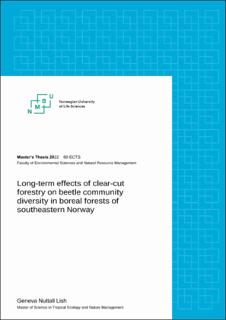| dc.description.abstract | Forest management regimes have led to global biodiversity declines. Norwegian boreal spruce-forests have been negatively impacted by clear-cutting for the last 70 years, a practice which shifts structural conditions of a forest. Determining whether biodiversity in these forests differ from forests never subjected to clear-cutting (hereafter termed ‘near-natural’) is essential to advise further forestry and conservation practices as the first clear-cut and replanted forests are now reaching a mature state. In this study, I compared forest characteristics and beetle diversity of two types of mature boreal forest which differ in previous management: near-natural forest, with a history of only selective logging, and previously clear-cut forest. We collected nearly 4000 beetles using a total of 324 window- and malaise-traps in five pairwise plots in Southeastern Norway. Along with beetle collection, we also recorded stand variables which encompassed both macro- and micro-climate conditions. From this, I calculated differences in beetle communities between former clear-cut and mature near-natural forest through richness and abundance mixed models and assemblage through diversity metrics. The near-natural and clear-cut forest management types were structurally different according to significant stand variables pertaining to canopy density, deadwood amount and deadwood diversity. Beetle richness and abundance as well as saproxylic beetles alone increased with the near-natural forest management type and deadwood stand variables, especially later decay stages. They also responded to macroclimate conditions like temperature. The uncommon species in the dataset, however, determined the differences between the assemblage of forest communities as they were mostly unique to different forest management types. The more abundant species were shared between the former clear-cut and the near-natural forests. These results highlight that despite 70 years since felling, clear-cut forests are different from near-natural forest in both their stand characteristics and beetle communities. As such, future conservation efforts should aim to conserve near-natural forests rather than convert them to clear-cut forests. | en_US |

